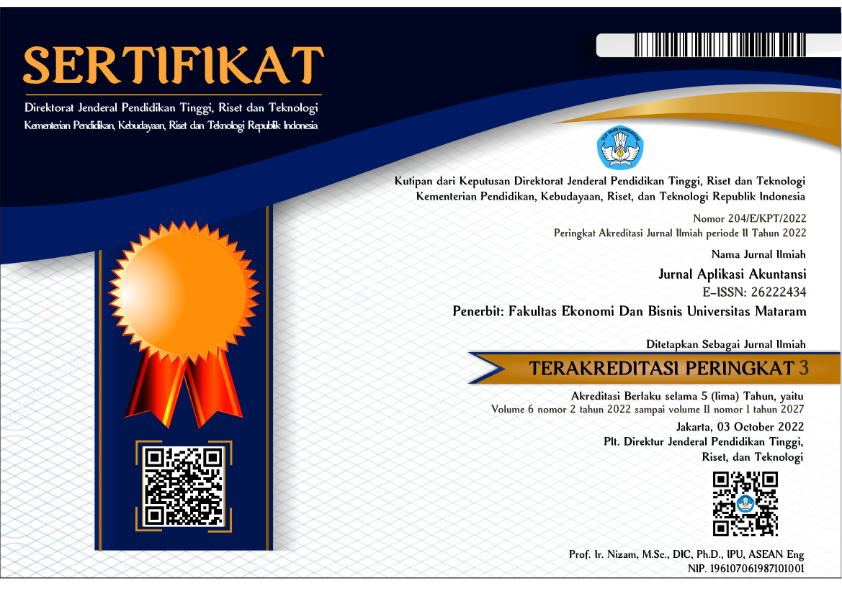PENDETEKSIAN FINANCIAL STATEMENT FRAUD MENGGUNAKAN FRAUD HEXAGON PADA PERUSAHAAN YANG TERINDEKS IDXBUMN20
DOI:
https://doi.org/10.29303/jaa.v9i1.432Keywords:
Beneish M-Score, financial statement fraud, Hexagon fraudAbstract
This research has a problem with financial statement fraud with the smallest percentage of cases but has the greatest impact on state losses among other frauds. This study aims to detect financial statement fraud using fraud hexagon in IDXBUMN20 indexed companies. There are six dimensions in the fraud hexagon consisting of stimulus, ability (Capability), conspiracy (Collusion), opportunity (Opportunity), rationalisation, and (arrogance). This study measures financial statement fraud using the Beneish M-Score. The population of this study were 20 BUMN companies indexed on IDXBUMN20. To select the sample, purposive sampling method was used for 15 state-owned companies for 3 years of observation with 45 observations. Logistic regression model as an analysis technique. Data processing with SPSS 26 which obtained results showing that financial stability proxy stimulus, auditor turnover proxy opportunity and ineffective supervision proxy rationalization affect financial statement fraud. While the change of directors proxy capability, the number of independent commissioners who hold concurrent positions proxy collusion, and the number of CEO photos in the annual report proxy arrogance have no effect on financial statement fraud.
References
Achmad, T., Ghozali, I., & Pamungkas, I. D. (2022). Hexagon Fraud: Detection of Fraudulent Financial Reporting in State-Owned Enterprises Indonesia. Economies, 10(1), 1–16. https://doi.org/10.3390/economies10010013
Agustin, M. D., Yufantria, F., & Ameraldo, F. (2022). Pengaruh Fraud Hexagon Theory Dalam Mendeteksi Kecurangan Laporan Keuangan (Studi Kasus Pada Perusahaan Asuransi Yang Terdaftar Di Bursa Efek Indonesia Periode 2017-2020). Journals of Economics and Business, 2(2), 47–62. https://doi.org/10.33365/jeb.v2i2.137
Alifa, R., & Rahmawati, M. I. (2022). Analisis Teori Hexagon Fraud Sebagai Pendeteksi Financial Statement Fraud. Jurnal Ilmu Dan Riset Akuntansi, 11(6), 1–25.
Apriliana, S., & Agustina, L. (2017). The Analysis of Fraudulent Financial Reporting Determinant through Fraud Pentagon Approach. Jurnal Dinamika Akuntansi, 9(2), 154–165. https://doi.org/10.15294/jda.v7i1.4036
Association of Certified Fraud Examiners Indonesia. (2019). Survei Fraud Indonesia 2019. Indonesia Chapter #111, 53(9), 1–76. https://acfe-indonesia.or.id/survei-fraud-indonesia/
Dianti, Y. (2017). 済無No Title No Title No Title. Angewandte Chemie International Edition, 6(11), 951–952., 1973, 5–24. http://repo.iain-tulungagung.ac.id/5510/5/BAB 2.pdf
Doxey, C. H. (2019). Analytics to Detect Financial Statement Fraud. The Fast Close Toolkit, 237–245. https://doi.org/10.1002/9781119554431.ch34
Ekonomika, F., Kristen, U., Wacana, S., Kristen, U., & Wacana, S. (2021). Pendeteksian Kecurangan Pelaporan Keuangan Melalui Fraud Pentagon Framework. 4(Februari), 35–54.
FATIMAH, I. I., & Wardani, M. K. (2023). Determinan Kecurangan Laporan Keuangan: Suatu Pendekatan Teori Fraud Hexagon. http://eprints.iain-surakarta.ac.id/6271/1/SKRIPSI FULL INNAYAH.pdf
Hildayani, R., & Serly, V. (2021). Pengaruh Tekanan, Peluang, Rasionalisasi dan Nilai Etika terhadap Intensi Kecurangan Karyawan: Studi Kasus pada Perusahaan BUMN. Jurnal Eksplorasi Akuntansi, 3(4), 734–748. https://doi.org/10.24036/jea.v3i4.422
Icih, Kurniawan, A., & Andini, A. (2021). Analysis The Effect Of Pentagon Fraud Theory In Detecting Financial Statement Fraud . Accounting Research Journal of Sutaatmadja, 05, 139–164.
Imtikhani, L., & Sukirman, S. (2021). Determinan Fraudulent Financial Statement Melalui Perspektif Fraud Hexagon Theory Pada Perusahaan Pertambangan. Jurnal Akuntansi Bisnis, 19(1), 96. https://doi.org/10.24167/jab.v19i1.3654
Keuangan, S., Perbankan, D. A. N., & G, C. T. (n.d.). FRAUDULENT FINANCIAL REPORTING : PENGUJIAN TEORI FRAUD PENTAGON PADA Jenis Sesi Paper : Full paper. 1–21.
Kusumosari, L. (2020). Analisis Kecurangan Laporan Keuangan Melalui Fraud Hexagon Pada Perusahaan Manufaktur yang Terdaftar di Bursa Efek Indonesia tahun 2014-2018. Universitas Negeri Semarang, 1–243.
Lionardi, M., & Suhartono, S. (2022). Pendeteksian Kemungkinan Terjadinya Fraudulent Financial Statement menggunakan Fraud Hexagon. Moneter - Jurnal Akuntansi Dan Keuangan, 9(1), 29–38. https://doi.org/10.31294/moneter.v9i1.12496
Md Nasir, N. A. binti, Ali, M. J., Razzaque, R. M. R., & Ahmed, K. (2018). Real earnings management and financial statement fraud: evidence from Malaysia. International Journal of Accounting & Information Management, 26(4), 508–526. https://doi.org/10.1108/IJAIM-03-2017-0039
Meidijati, & Amin, M. N. (2022). Detecting Fraudulent Financial Reporting Through Hexagon Fraud Model: Moderating Role of Income Tax Rate. International Journal of Social and Management Studies (IJOSMAS), 3(2), 311–322. http://www.ijosmas.org
Miftahul Jannah, V., Andreas, A., & Rasuli, M. (2021). Pendekatan Vousinas Fraud Hexagon Model dalam Mendeteksi Kecurangan Pelaporan Keuangan. Studi Akuntansi Dan Keuangan Indonesia, 4(1), 1–16. https://doi.org/10.21632/saki.4.1.1-16
Mukaromah, I., & Budiwitjaksono, G. S. (2021). Fraud Hexagon Theory dalam Mendeteksi Kecurangan Laporan Keuangan pada Perbankan yang Terdaftar di Bursa Efek Indonesia Tahun 2015-2019. Jurnal Ilmiah Komputerisasi Akuntansi, 14(1), 61–72. http://journal.stekom.ac.id/index.php/kompakpage61
Nadziliyah, H., & Primasari, N. S. (2022). Analisis Fraud Hexagon Terhadap Financial Statement Fraud Pada Perusahaan Sektor Infrastruktur, Utilitas Dan Transportasi. Accounting and Finance Studies, 2(1), 21–39. https://doi.org/10.47153/afs21.2702022
Narsa, N. P. D. R. H., Afifa, L. M. E., & Wardhaningrum, O. A. (2023). Fraud triangle and earnings management based on the modified M-score: A study on manufacturing company in Indonesia. Heliyon, 9(2), e13649. https://doi.org/10.1016/j.heliyon.2023.e13649
Octaviani, K., Sagala, E., & Silviana. (2021). The Influence Of Fraud Hexagon Elements On Fraudulent Financial Reporting At The Banking Companies Listed On The Indonesian Stock Exchange Periode 2018-2020. Webology, 18(6), 1–11. http://www.webology.org
Purnama, D., Mutiarani, G., Mahasti, Y., & Jurica, L. (2022). Pengujian Kecurangan Laporan Keuangan Menggunakan Fraud Hexagon Model. Media Riset Akuntansi, 12, 2088–2106.
Rahma, N. N., & Sari, S. P. (2023). Detection of Fraud Financial Statements through the Hexagon Model Vousinas Fraud Dimensions: Review on Jakarta Islamic Index 70. International Journal of Latest Research in Humanities and Social Science, 6(1), 152–159. www.ijlrhss.com
Riantika, R. L. (2021). Anti Fraud dan Whistleblowing Intention: Peran Intensitas Moral dan Pengambilan Keputusan Etis. AFRE (Accounting and Financial Review), 4(1), 95–106. https://doi.org/10.26905/afr.v4i1.5957
Sabrina, O. Z., Fachruzzaman, Midiastuty, P. P., & Suranta, E. (2020). Pengaruh Koneksitas Organ Corporate Governance, Inneffective Monitoring dan Manajemen Laba Terhadap Fraudulent Financial Reporting (The Effect of Corporate Governance, Ineffective Monitoring and Earnings Management Concept On Fraudulent Financial Reportin. Jurnal Akuntansi Keuangan Dan Manajemen, 1(2), 109–122.
Sari, S. P., & Nugroho, N. K. (2020). Financial Statements Fraud dengan Pendekatan Vousinas Fraud Hexagon Model: Tinjauan pada Perusahaan Terbuka di Indonesia. Islamic Economics, Finance, and Banking (ACI-IJIEFB), 409–430.
Septriani, Y., & Desi Handayani, dan. (2018). Mendeteksi Kecurangan Laporan Keuangan dengan Analisis Fraud Pentagon. 11(1), 11–23. http://jurnal.pcr.ac.id
Setiawati, E., & Baningrum, R. M. (2018). Deteksi Fraudulent Financial Reporting Menggunakan Analisis Fraud Pentagon : Studi Kasus Pada Perusahaan Manufaktur Yang Listed Di Bei Tahun 2014-2016. Riset Akuntansi Dan Keuangan Indonesia, 3(2), 91–106. https://doi.org/10.23917/reaksi.v3i2.6645
Setyono, D., Hariyanto, E., Wahyuni, S., & Pratama, B. C. (2023). Penggunaan Fraud Hexagon dalam Mendeteksi Kecurangan Laporan Keuangan. Owner, 7(2), 1036–1048. https://doi.org/10.33395/owner.v7i2.1325
Situngkir, N. C., & Triyanto, D. N. (2020). Detecting Fraudulent Financial Reporting Using Fraud Score Model and Fraud Pentagon Theory : Empirical Study of Companies Listed in the LQ 45 Index. The Indonesian Journal of Accounting Research, 23(03), 373–410. https://doi.org/10.33312/ijar.486
Suripto; Karmilah. (2021). the Influence of the Audit Committee and Fraud Diamond. International Journal of Economics, Bussiness and Accounting Research (IJEBAR), 2021(3), 1–22.
Usmar, D., & Nurfadillah, I. A. (2016). Pengaruh Efektifitas Pengendalian Internal Terhadap Kecurangan Akuntansi Pada PT Inka Mutiara Mas. JAWARA : Jurnal Wawasan Dan Riset Akuntansi, 4(1), 40–53.
Vona, L. W. (2017). Fraud Data Analytics Methodology. Fraud Data Analytics Methodology, 285–310. https://doi.org/10.1002/9781119270331
Vousinas, G. L. (2019). Advancing theory of fraud: the S.C.O.R.E. model. Journal of Financial Crime, 26(1), 372–381. https://doi.org/10.1108/JFC-12-2017-0128
Wijaya, T., & Witjaksono, A. (2023). Unmasking Financial Deception: Unraveling the Fraud Hexagon’S Influence on Detecting Financial Statement Fraud in Indonesian Public Companies. Journal of Applied Finance and Accounting, 10(1). https://doi.org/10.21512/jafa.v10i1.9927
Yusuf, F. (2023). Dugaan manipulasi laporan keuangan perusahaan BUMN Karya Waskita dan Wika 2023. April. https://www.researchgate.net/publication/379602579
Downloads
Published
How to Cite
Issue
Section
License
Copyright (c) 2024 Maulida, Linda Rahmazaniati, Sari Maulida Vonna, Said Mahdani, Fatmayanti

This work is licensed under a Creative Commons Attribution-NonCommercial-ShareAlike 4.0 International License.









